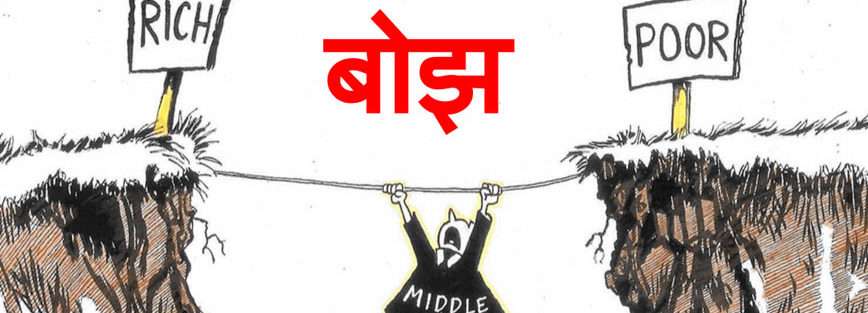Time to focus on the middle class burdened by taxes
The government spends the collected revenue in various development schemes and subsidies etc. If we look at the international tax system, then taxes are classified in the category of direct tax and indirect tax. Taxes in India are similarly graded. Income tax, corporate tax, gift tax etc. are direct taxes. There are indirect taxes like Goods and Services Tax, Custom Duty, Stamp Duty etc.
When compared globally, tax rates in India are quite high. Due to the high rate of both direct tax and indirect tax, the Indian tax system falls heavily on the common man.
When the GST was implemented in July 2017, one thing was loudly publicized that this tax system would be in the form of 'One Nation, One Tax' system, which would reduce the impact of taxes on the common man. The opposite happened. Today the common man especially the middle class is suffering to bear the burden of many taxes. Apart from Income Tax and Goods and Services Tax, many types of taxes are also affecting the common man.
Presently the population of India is about 140 crores, of which about 46.5 crores belong to the middle-income group. There are about 8 crore taxpayers in the country, out of which taxpayers showing income above Rs 1 crore are only two lakh and taxpayers showing income between Rs 10 lakh and Rs 1 crore are about one crore. Thus, most of the taxpayers belong to the middle-income group belonging to the income group below Rs 10 lakh. This middle-income group, pays about 15.22 percent of its income as income tax and 18-20 percent as tax on expenses related to household, utility and food expenses. After this , if he spends the remaining amount in the form of savings and investments in addition to lifestyle, then he has to pay tax on that too. Thus, a middle class has to pay about 50 to 55 percent of its income as tax. That is, he is able to effectively use 50 to 45 percent of the income for himself.
The common man after paying income tax on his income pays GST on almost all the items of need. Still, if you are able to save some amount and buy land and building, then pay stamp and registration fee, if you buy a vehicle, pay road tax, pay tax on petrol and diesel along with toll tax. Still, if you
save some money and invest in savings schemes, then pay income tax again in the form of TDS on the interest earned on it.
The primary needs of the low-income group are food, clothing, shelter, education, medical care free of cost or at subsidized rates. These are readily available for the higher income group. Along with this, due to the high
salaried and directors of companies, etc., due to the institutional provisions related to vehicle, phone, house,
medical etc., the impact of indirect taxes on these facilities is less and this class is saved from many indirect
taxes. Ultimately, it is the middle-income group that seems to be struggling between these needs and their income. Since almost all the free facilities available to the low-income group are funded by the taxes received by the government, which makes it clear that only one third of the Middle Class country's population is bearing the burden of about two thirds of the country's population. That is why the middle-income group is badly affected by the tax system.
To make the concept of welfare state meaningful, the government should undertake comprehensive reforms in the tax structure, which may include reduction of tax rate, reduction in the number of taxes, etc. At the same time, instead of providing free goods to the large population of the country, plans should be made to take cooperation from them in productive work and their effective implementation should be done, so that this population can prove to be an 'asset' for itself and the country. Quick and effective policy decisions are necessary in this direction, otherwise the situation can become very explosive. Reformative measures are necessary before the situation worsens, so that the middle class can breathe a sigh of relief.
Keywords: Subsides, Direct Tax and Indirect Tax, Goods and Services Tax, Custom Duty, Stamp Duty, Middle Income Group.



